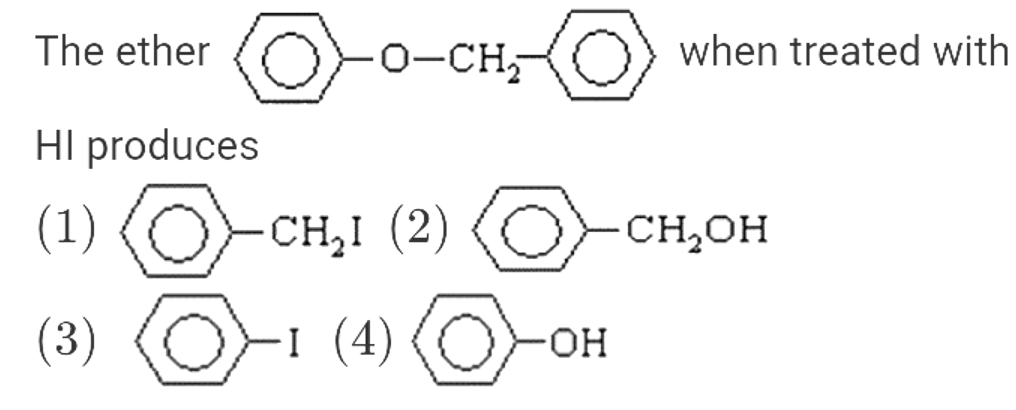How is peroxide in ether detected and removed ?
To detect and remove peroxides in ethers, we can follow these steps:
Step 1: Detection of Peroxide in Ether
1. Preparation of Reagents: Prepare a freshly made solution of ferrous sulfate (FeSO4).
2. Shaking the Ether: Take the ether sample and shake it with the freshly prepared FeSO4 solution.
3. Addition of Potassium Cyanide: After shaking, add potassium cyanide (KCN) to the mixture.
4. Observation of Color Change: Look for a color change. The appearance of a red color indicates the presence of peroxides in the ether.
Step 2: Removal of Peroxide from Ether
1. Preparation of Potassium Iodide Solution: Prepare an aqueous solution of potassium iodide (KI).
2. Addition of KI to Ether: Add the potassium iodide solution to the ether containing peroxides.
3. Oxidation-Reduction Reaction: The peroxide will oxidize the potassium iodide to iodine (I2), while the peroxide itself will be reduced to ether.
4. Formation of Ether: The final products will be ether and oxygen (O2), effectively removing the peroxide.
Summary of the Process
- Detection: Shake ether with FeSO4 and KCN; red color indicates peroxide.
- Removal: Add KI to ether; peroxide oxidizes KI to iodine and reduces to ether.
---
1. Preparation of Reagents: Prepare a freshly made solution of ferrous sulfate (FeSO4).
2. Shaking the Ether: Take the ether sample and shake it with the freshly prepared FeSO4 solution.
3. Addition of Potassium Cyanide: After shaking, add potassium cyanide (KCN) to the mixture.
4. Observation of Color Change: Look for a color change. The appearance of a red color indicates the presence of peroxides in the ether.
1. Preparation of Potassium Iodide Solution: Prepare an aqueous solution of potassium iodide (KI).
2. Addition of KI to Ether: Add the potassium iodide solution to the ether containing peroxides.
3. Oxidation-Reduction Reaction: The peroxide will oxidize the potassium iodide to iodine (I2), while the peroxide itself will be reduced to ether.
4. Formation of Ether: The final products will be ether and oxygen (O2), effectively removing the peroxide.
- Detection: Shake ether with FeSO4 and KCN; red color indicates peroxide.
- Removal: Add KI to ether; peroxide oxidizes KI to iodine and reduces to ether.
Topper's Solved these Questions
- ALCOHOLS, PHENOLS AND ETHERS Book:ICSEChapter:ALCOHOLS, PHENOLS AND ETHERS Exercise:EXERCISE (PART-II Descriptive Questions) (LONG ANSWER QUESTIONS)
Explore 20 Videos
- ALCOHOLS, PHENOLS AND ETHERS Book:ICSEChapter:ALCOHOLS, PHENOLS AND ETHERS Exercise:ISC EXAMINATION QUESTIONS
Explore 25 Videos
- ALCOHOLS, PHENOLS AND ETHERS Book:ICSEChapter:ALCOHOLS, PHENOLS AND ETHERS Exercise:EXERCISE (PART-II Descriptive Questions) (VERY SHORT ANSWER QUESTIONS)
Explore 104 Videos
- ALCOHOLS , PHENOLS AND ETHERS Book:ICSEChapter:ALCOHOLS , PHENOLS AND ETHERS Exercise:SOURCE BASED QUESTIONS
Explore 4 Videos
- ALDEHYDES, KETONES AND CARBOXYLIC ACIDSBook:ICSEChapter:ALDEHYDES, KETONES AND CARBOXYLIC ACIDSExercise:EXERCISE (PART-II DESCRIPTIVE QUESTIONS) ( LONG ANSWER QUESTIONS)
Explore 478 Videos
Similar Questions
Knowledge Check
Ethers in contact with air for a long time form peroxides. The presence of peroxide in ether can be tested by adding Fe2+ ions in it and then
AKCNS is addedBSnCl2 is addedCHgCl2 is addedDKI is addedHydrogen peroxide is
Aan oxidising agentBa reducing agentCboth an oxidising and a reducing agentDneither oxidising nor reducing agent
